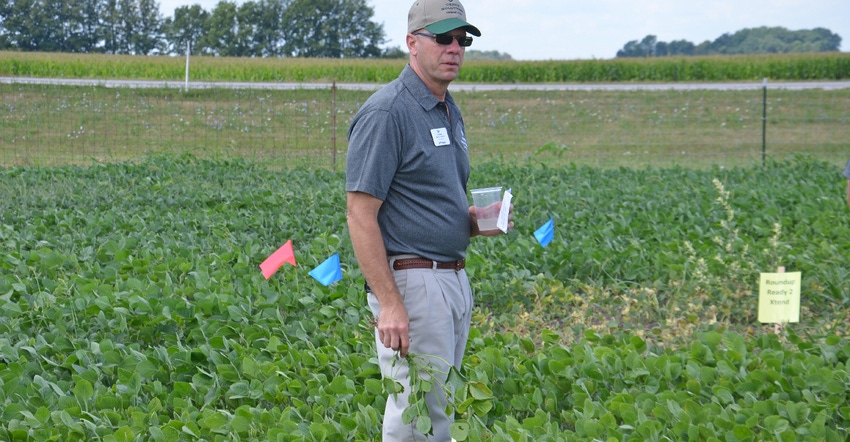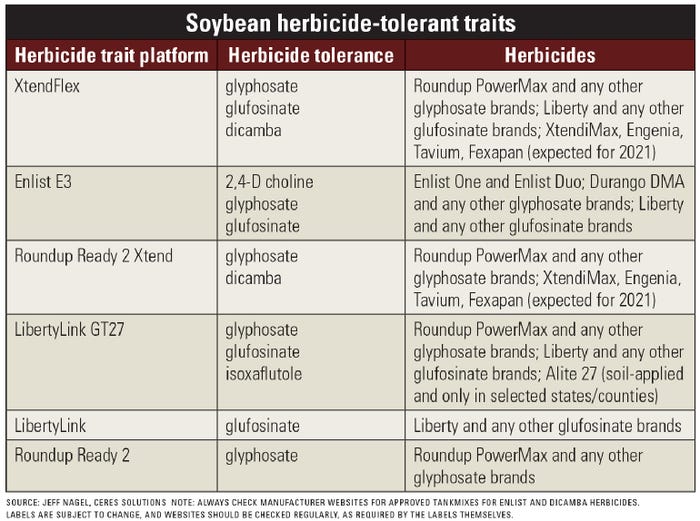
Approval of soybeans with the XtendFlex trait for 2021, plus Enlist 3 soybeans and other herbicide-tolerant systems already on the market, means more choices for 2021. How do you decide which system will be the best going forward?
To address this topic, Farm Progress posed several questions to two industry experts: Bill Johnson, Purdue University Extension weed control specialist, and Jeff Nagel, an agronomist with Ceres Solutions, based near Lafayette, Ind. Find more discussion from Johnson and Nagel at Custom-build a soybean postemergence system and Factor in weed resistance when selecting herbicide system.
What technologies will be available for 2021 soybean weed control? What chemistry is each one tolerant to?
Johnson: You still have roundup Ready Xtend soybeans, tolerant to dicamba and glyphosate. For 2021, Roundup Ready XtendFlex is approved, with tolerance to dicamba, glyphosate and glufosinate. The added ingredient is glufosinate, which is the active ingredient in Liberty. You also have LibertyLink soybeans tolerant to glufosinate as an option. Enlist E3 soybeans are tolerant to 2,4-D, glyphosate and glufosinate. LibertyLink GT27 soybeans are another choice, with tolerance to glufosinate, glyphosate and isoxaflutole, the active ingredient in Balance.
Nagel: You can also still find Roundup Ready soybeans, which are tolerant to glyphosate. See the chart for full details.

What are the strengths and weaknesses on weed control of each system?
Johnson: One can consult the herbicide efficacy tables in any state Extension weed control guide to see what the strengths of each herbicide are. Generally speaking, here are the strengths of each herbicide:
Glyphosate. Very good on grasses, suppression of many broadleaves except glyphosate-resistant biotypes of horseweed (marestail), giant ragweed, waterhemp and Palmer amaranth. It’s somewhat weak on things like velvetleaf, morningglories and pigweeds, in general.
Glufosinate. Suppression or control of many species when they are small, at 4 inches or less. Activity is really compromised on large weeds. It tends to struggle with barnyardgrass, yellow foxtail, perennial grasses and large broadleaf weeds.
2,4-D and dicamba. Broadleaf herbicides. Very good on giant ragweed. They struggle with pigweeds and horseweed when they get large, which we define as 4 inches tall.
Isoxaflutole. This is a soil-applied herbicide for grass and small-seeded broadleaf weeds which offers some suppression of giant ragweed. It provides very good control of foxtail, velvetleaf and waterhemp if there is enough rain for activation.
Nagel: Glyphosate-resistant weeds such as waterhemp, Palmer amaranth, marestail and giant ragweed have been the driver for the adoption of newer herbicide trait platforms. Waterhemp and Palmer amaranth have particularly been difficult to control. We now rely on dicamba, glufosinate, which is Liberty, and 2,4-D choline to help control the above weeds with postemergence applications.
Glyphosate still adds weed control value and is nearly always added as a tankmix partner with dicamba and Enlist One applications. Glyphosate is also added when needed with Liberty on Enlist E3 and LibertyLink GT27 soybeans. The active ingredients of these herbicides have been on the market for years, and we know what to expect with summer annual weed control. Waterhemp and Palmer control is generally acceptable when spraying them when small, at heights less than 4 inches, and become inconsistent when weeds get larger.
Can you make general comparisons about what to expect from control with these systems?
Nagel: Dicamba is good on most broadleaves, including marestail and giant ragweed. It struggles with velvetleaf. 2,4-D choline is also good on most broadleaves, including giant ragweed. It may not be as good on overwintered marestail and black nightshade. Glufosinate is good on most broadleaves, including in-crop marestail. It struggles more with lambsquarters, larger giant ragweed and certain grasses.
Glufosinate is a contact herbicide and is more sensitive to environmental conditions. As an example, it works well on marestail with warm and sunny conditions in crop, but may not achieve as satisfactory control of overwintered marestail on a cool and cloudy spring day as a burndown. 2,4-D continues to be inconsistent in controlling overwintered marestail in the spring, even at higher rates we can use in the Enlist system.
Whichever system a grower chooses, what else is needed for good weed control?
Johnson: Besides building the program with the residual as the backbone, add something to the weed control program that doesn’t involve a herbicide. That might be tillage, cover crops or a third crop in the rotation. Spray postemergence herbicides when weeds are small.
Nagel: We need to follow these herbicide management strategies.
Fall management. Use a fall-applied herbicide or effective tillage to control fall-emerged marestail. Tillage may not be an option on Highly Erodible Land or in conservation-tillage systems, so the fall-applied herbicide is the best option. Most vertical-tillage tools don’t adequately control fall-emerged weeds.
Clean start. Start clean with an effective tillage pass or spring burndown program to control any emerged weeds.
Residual application. Use a residual herbicide with two or more effective sites of action on target weeds.
Postemergence application. Spray post-emergence herbicides on weeds less than 4 inches tall.
In-season control. Tank-mix a Group 15 residual herbicide with postemergence herbicides to control in-season germination of waterhemp or Palmer amaranth.
Cultural practices. Use cultural practices such as narrow soybean row spacing and cover crops to aid herbicide programs.
As an industry, it’s imperative we utilize soil-applied residual herbicides at or near planting in weed control programs. Using soil-applied residual herbicides minimizes the selection pressure on postemergence applications. Otherwise, we will quickly move to weeds resistant to dicamba, 2,4-D and glufosinate.
About the Author(s)
You May Also Like




